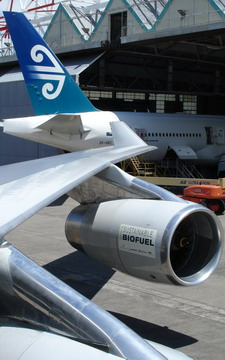Boeing looks at greener partnerships
By Lu Haoting (China Daily)
2009-10-12 08:01
|
|
After producing aircraft components for Boeing for more than two decades, China is expected to become the US airplane manufacturer's research and development (R&D) partner for environmentally friendly technologies that will make the aviation industry greener.
A key part of the partnership will be to develop biofuels that will allow the aviation industry to have a low-carbon lifecycle footprint, said Matthew Ganz, vice president and general manager of Boeing Research & Technology, a central R&D unit of The Boeing Co.
|
Air New Zealand conducted a two-hour flight in December 2008 using a fuel blend of 50 percent jatropha and 50 percent standard jet fuel to power one of four engines of its Boeing 747-400. |
Boeing is currently in talks with the Chinese Academy of Sciences and several Chinese universities about the potential partnership, Ganz said. But he declined to release further details about the form of the partnership and the amount of investment involved.
The US aircraft producer has been collaborating with aircraft engine companies and airlines to explore the adoption of biofuels in aviation.
Biofuels are produced from renewable biological resources such as plants, rather than traditional fossil fuels. They have a lower environmental impact than petroleum-based fuels.
First-generation biofuels, such as ethanol, might compete with food producing and are not suitable fuels for powering commercial aircraft because many of these fuels don't meet the high performance or safety specifications for jet fuel. Boeing is mainly looking at second-generation biofuels, sourced from feedstocks such as jatropha, camelina, algae and halophytes.
"The near term collaboration opportunities for Boeing and China could be the commercialization plans for jatropha," said Mike Hurd, deputy director of environmental services strategy for Boeing Commercial Aviation Services.
"China has tremendous resources and could be a leader in biofuels development," Hurd said.
Jatropha is a plant that produces seeds containing inedible oil that can be used to produce fuel. Each seed produces 30 percent to 40 percent of its mass in oil. Jatropha can be grown in a range of difficult soil conditions, including arid and non-arable areas and therefore is less likely to displace food crops.
Wild and planted jatropha can be found in southwestern China's Yunnan, Sichuan and Guizhou provinces and Guangxi Zhuang autonomous region. Yunnan province has about 33,000 hectares of jatropha, according to statistics from the provincial forestry authorities.
Planting jatropha has become a focus for the local government's biofuel development plans since 2007. The province plans to develop about 666,700 hectares of jatropha forest by 2017, and the plants will be able to provide 1 million tons of biodiesel annually.
China has been promoting the development of biofuel plantations to reduce the country's dependence on imported crude oil. The country is expected to have 13 million hectares of biofuel plantations by 2020 that can yield 6 million tons of biodiesel annually, Xinhua News Agency reported.
Biofuel flight
Boeing has performed test flights using biofuels with four airlines since early 2008.
The goal is to certify biofuels as safe for aviation use by 2013, according to the Air Transport Action Group (ATAG), an independent coalition of organizations and companies representing the global air transport industry. ATAG advocates environmentally responsible development of aviation infrastructure.
Hurd said policy incentives are necessary to accelerate the adoption of biofuels in the airline industry.
The European Union in August warned nearly 4,000 airlines that they would be banned from airports across Europe if they fail to cut their carbon footprints by 2012.
The airlines have to join the European Union's emission trading plan by 2012 or face penalties flying there. The plan requires airline emissions in Europe to drop by 3 percent by 2012 and 5 percent by 2013.
The aviation industry is responsible for 2 percent of global carbon dioxide emissions, according to the United Nations Intergovernmental Panel on Climate Change.
But the industry is fast growing at 5 percent annually, which means its carbon dioxide emissions might increase to 3 percent by 2050.








